Make protein powder at home with just one ingredient and 15 minutes. It’s naturally vegan, allergen friendly, and great to add to smoothies, baked goods, and sauces. You can even customize it with additional flavors.
This post may contain affiliate links. Read my policy page for more information.
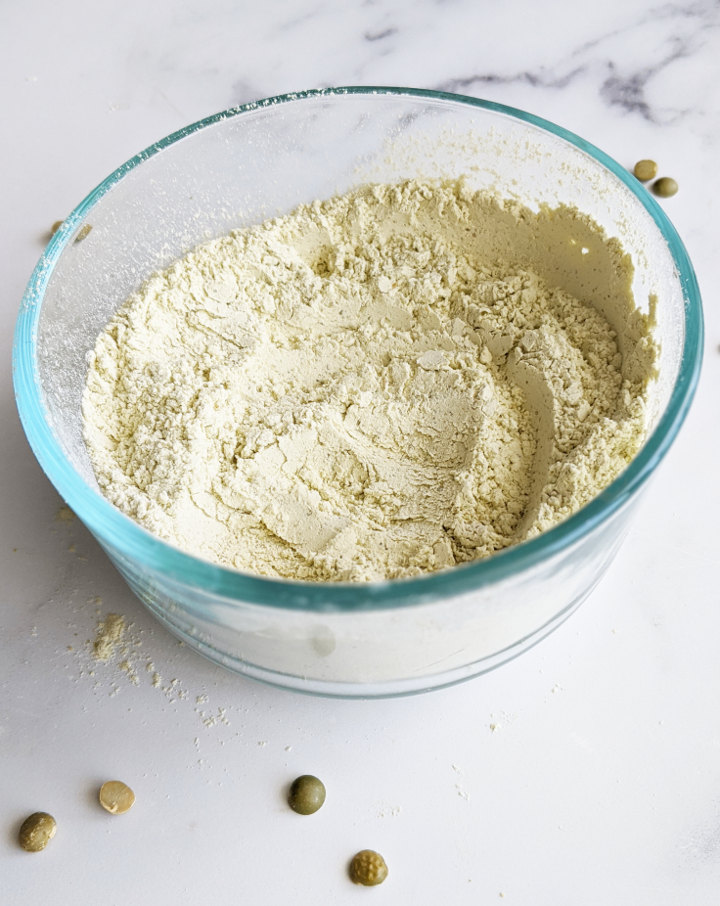
Did you know you can make your own protein powder at home? It’s actually a really simple process that I only just recently discovered when I had a bag of peas I needed to use up before my move and someone recommended me this video from Comer Vegano. I never realized how simple it can be. In this article I’ll show you just how easy it is and how to use it in a variety of ways.
I don’t normally consume protein powders because I don’t find them all that necessary for the price, but now that I know how to make my own at home, I think I’ll be enjoying them a lot more.
As a vegan, one might think that it is difficult to get enough protein through diet without supplementing. The truth is that protein is not that difficult to acquire if certain criteria are met. If you are eating a mostly whole foods plant-based diet and consuming enough calories for your energy and activity requirements, then it’s virtually impossible to not get enough protein unless there’s an underlying health condition.
Our protein requirements are not as much as the protein supplement companies would have us believe. In fact, the Recommended Dietary Intake of protein for an average adult is .36 grams of protein per pound of body weight or 0.8 grams of protein per kilogram of body weight.
That’s around 50 grams of protein per day for the average sedentary person. It may not seem like much but that’s two standard deviations above the minimum to prevent protein deficiency. So don’t worry, you won’t be withering away.
If you are more active and do weight lifting or endurance exercise you may need more protein. Some suggest increasing it to .65 grams of protein per pound of body weight. Either way, the rule above regarding eating enough on a whole foods plant-based diet should cover your protein needs.
However, from time to time we run short on time and need something to keep us full in between meals. We also may have physique goals that require higher protein intakes. That’s when protein powders can be beneficial.
You can actually make your own DIY protein powder out of several things: nuts, seeds, whole grains, beans, etc. But today I’m going to show you how to make it out of peas.

Health Benefits of Peas
Peas are a lesser known source of protein but it’s becoming more popular as more and more pea protein products and supplements are coming to the market. Peas are a great option for many because they are allergen friendly and easy to digest.
One cup of cooked split peas contains over 16 grams of protein. It’s also high in minerals such as Iron, Zinc, Manganese, Phosphorus, and Copper. It’s high in folate, the natural form of folic acid, and contains several B vitamins.
Peas also contain over 20 grams of fiber in one cup! Most Americans do not even get that much in one day even though the Daily Recommended Intake of Fiber on average is around 30 grams. Higher fiber intake can help lower cholesterol and is beneficial in managing blood-sugar.
And contrary to popular belief, there’s no such thing as an incomplete protein. All plants contain all nine essential amino acids. The term “incomplete protein” really just means that one or more of the essential amino acids are present in limited amounts. For peas, that is Methionine but this should not be a concern as long as you are diversifying your protein sources through out the day. Check out this article for the top plant-based sources of protein for a balanced vegan diet.
Antinutrients in Peas
A concern when it comes to consuming legumes are the presence of antinutrients. These are essentially compounds that block the absorption of other nutrients.
The main antinutrients found in peas are phytic acid and lectins which may interfere with the absorption of minerals such as iron, calcium, zinc, and magnesium. These can also affect digestion and cause bloating.
Levels of antinutrients are lower in peas than other legumes so for the average healthy person, they are not a concern. They are unlikely to cause problems unless eaten in large quantities.
In the case of pea protein powder, the quantity is small enough to not cause issues but if you notice any discomfort with digestion you can start with a smaller amount. Two tablespoons per serving is a good starting point.
Best Type of Peas for Protein Powder
There are several different types of peas to make protein powder with but today we’ll be making it with dry split peas. I’ve seen it made by using green peas, yellow peas, or even frozen peas, but these require an extra step of dehydrating.
Split peas, also known as field peas, are already dry which makes the process a lot faster. Field peas are dried with the outer shell removed, revealing the two halves. Dried peas will keep for several months if stored in an airtight container in a cool, dry, dark place such as a pantry. If you need to store them for longer, you can keep them in the refrigerator.
These are the same type of peas used to make commercial protein powders, however, they typically extract the starches and fiber, leaving a higher concentrated protein powder.
Our homemade version will not have as high amount of protein per scoop, but has the added benefit of additional fiber and nutrients that would otherwise have been removed.
How Much Protein is in Pea Protein Powder?
One cup of dry split peas has around 45 grams of protein. When processed into a fine powder, it makes just over one cup of protein powder.
Most commercial brand serving sizes are equivalent to 1/4 cup and contain around 20 grams of protein.
Based on this example, one serving of our homemade pea protein powder contains just over 11 grams of protein.
What you need
To make your own pea protein powder you will need a few things:
- A high-speed blender, food processor or spice grinder.
- A sieve, or fine mesh strainer to separate the flour/powder from any larger pieces.
- An airtight storage container.
How to Make
The process I’m going to show you is essentially making a pea flour because we are not extracting anything. We are simply processing the peas into a flour.
This process is the simplest because there is no need to presoak, sprout, or cook. In fact, you can eat raw split peas. That’s why we can make a DIY protein powder that can be used in smoothies and other raw foods like energy balls. One word of caution: You cannot do this with all legumes, especially kidney beans, as they can make you sick if not cooked first.
Here’s the easy process:
1. Place peas in your blender or food processor. I use a Ninja blender but any high-speed blender or food processor will do. Make sure whatever appliance you use is completely dry. You do not want any moisture in it or you will end up with a paste instead of a flour.
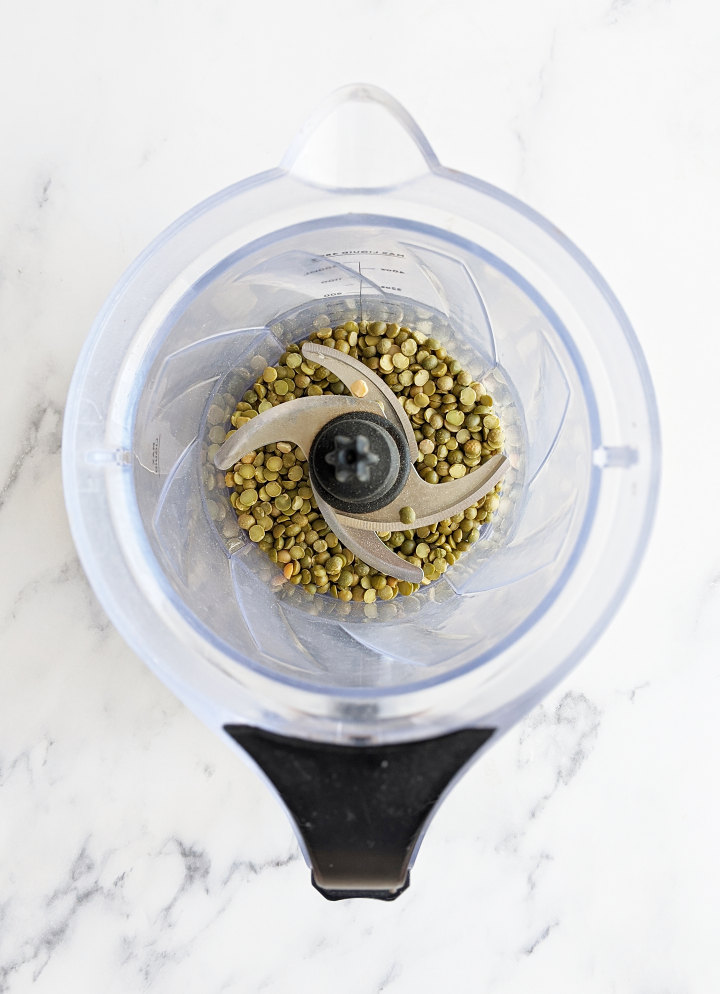
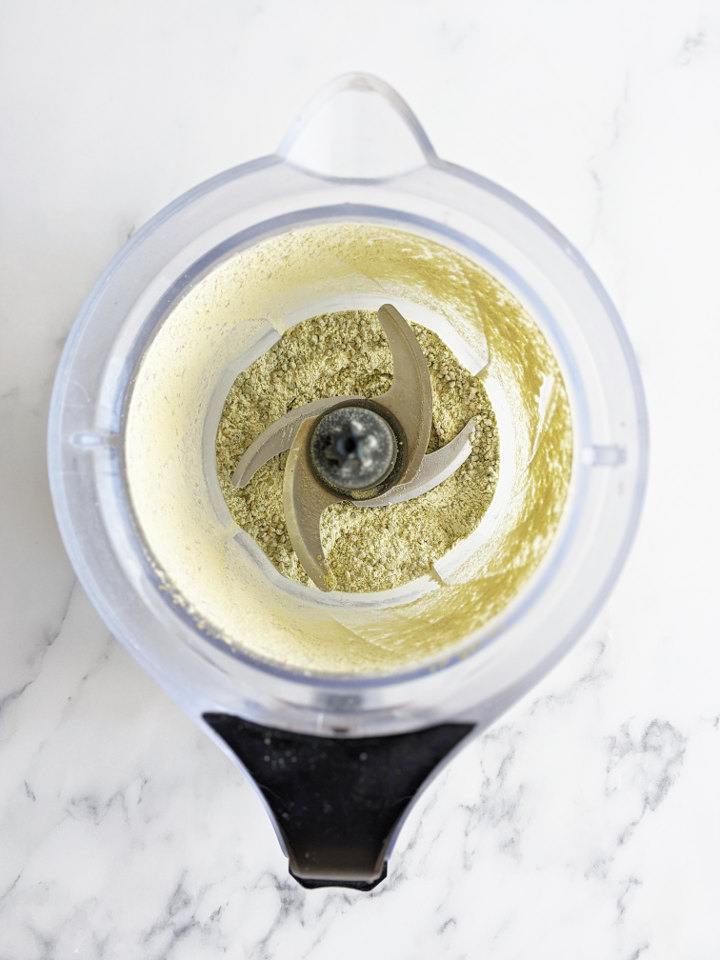
2. Blend for around 3 minutes. Make sure any openings are covered while it’s running so you don’t have pea flour wafting out of it.
3. Sift the processed peas over a bowl to separate the powder from any of the larger pieces.

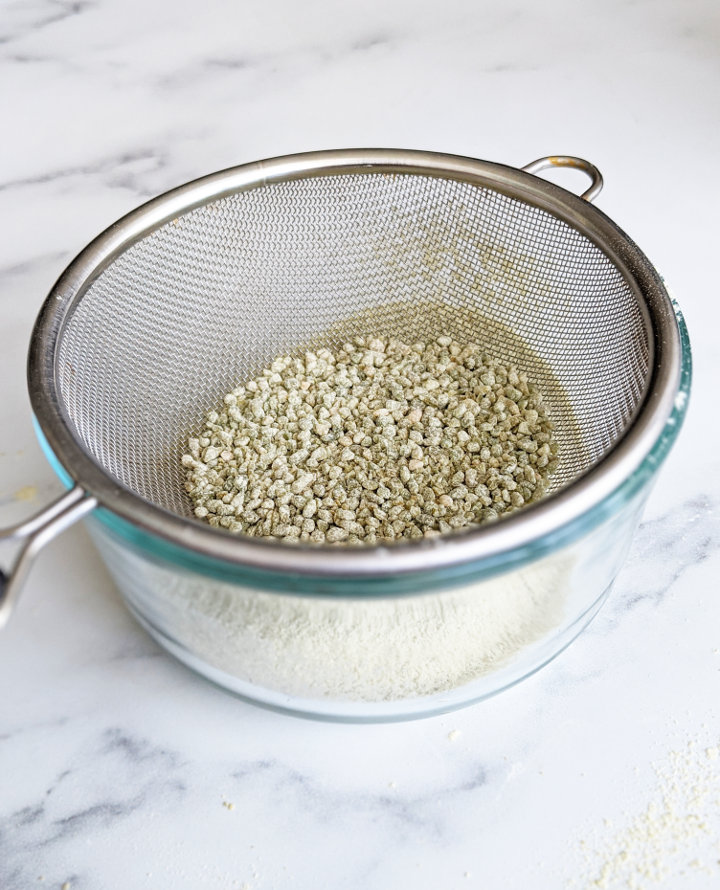
4. Reprocess the larger pieces in your blender for another 3 minutes and repeat step 3.
5. You now have pea protein powder!

Any leftover larger pieces can be ground using a coffee or spice grinder, or throw into a soup or stew so they don’t go to waste. They’re so small that they should cook quickly.
How to Store
To keep your homemade pea protein powder fresh for as long as possible, you’ll want to store it in an airtight container in the refrigerator. It should last in there at least one week but you can also freeze for longer. No need to thaw, it should stay as a powder when frozen.
How to Use
You can use pea protein powder in a number of things. Adding it to smoothies is perfect because it bulks up the smoothie, making it more filling and satiating. Usually 2-4 tablespoons is a good quantity to add to smoothies depending on your protein needs and taste preferences.
You can also use it in baked goods. Replace a little of the flour with pea protein. You can do the same with things like pancakes or waffles as well.
It can also be added to soups or sauces as a thickener.
Or add it to these No Bake Granola Bars or a bowl of oatmeal for some extra protein.
Why Not Just Buy Store-Bought Protein Powder?
You certainly can but it comes at a cost. First, it’s more expensive. You’ll be spending upwards of $20 per bag (I’ve even seen some for as much as $60) which might not even last you two weeks.
Making it at home can take less than $2 and just 15 minutes of your time. Additionally, most store-bought versions are going to have added sugars and natural flavors which are proprietary ingredients that are not necessarily natural at all.
I like knowing exactly what is in my food, so I like that making my own protein powder gives me the control of what goes into it. I can even customize it to my own preferences by adding different add-ins to flavor it.
Customizations
There are several ways to up the protein content even more or add some flavor to your protein powder. Although we can add flavors, I still find it best to blend into a smoothie rather than mix directly into water or plant milk.
Extra protein
- 1/4 cup raw flax seeds
- 1/4 cup hemp seeds
- 1/4 cup chia seeds
- 1/3 cup oat flour
- 1/4 cup coconut flour
Flavors
- 1 Tablespoon cocoa powder or cacao
- 1 Tablespoon coconut sugar
- 1 teaspoon maca powder
- 1/4 teaspoon ground cinnamon
- 1 teaspoon stevia powder
- 1/2 teaspoon vanilla bean powder
Let us know if you make this protein what your favorite custom combinations are!
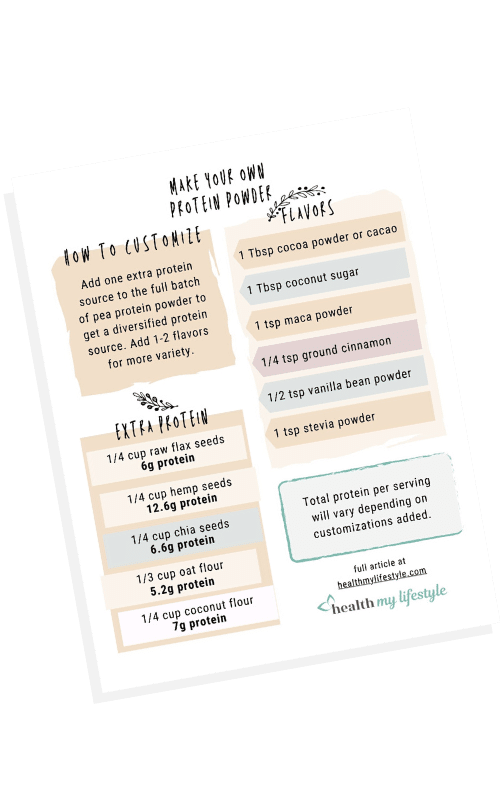
Here’s my favorite:
- 1/3 cup pea protein powder
- 1 tablespoon cocoa powder
- 1/4 teaspoon cinnamon
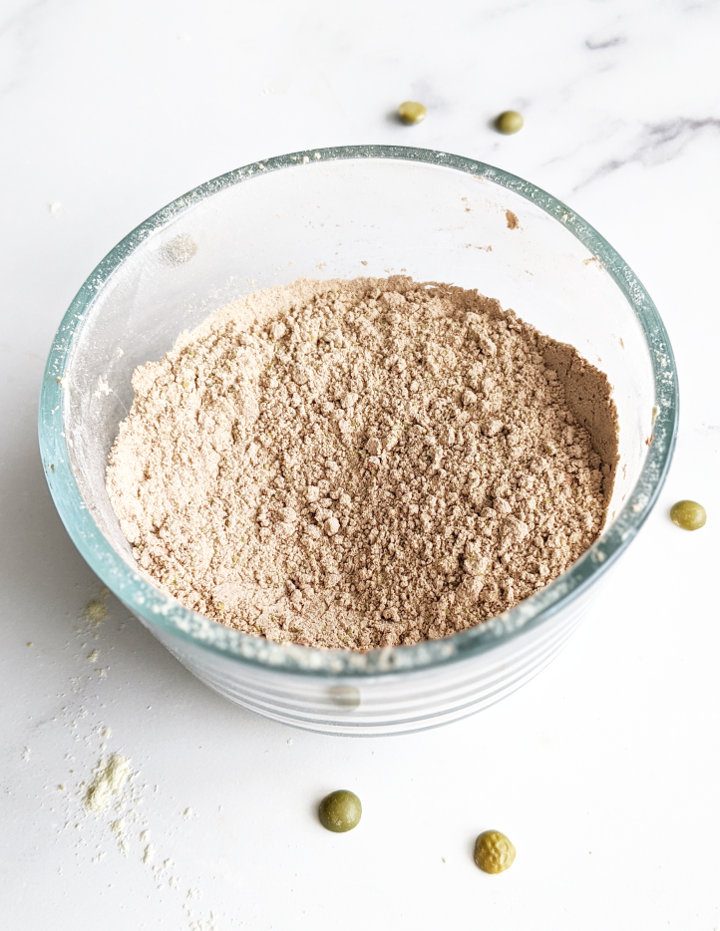
Add 4 Tablespoons of it to a smoothie with 1 cup frozen cherries, 1 banana, and 1 cup water or plant milk. It’s like a chocolate cherry black forest smoothie! Add more cocoa powder to make it even more chocolatey.
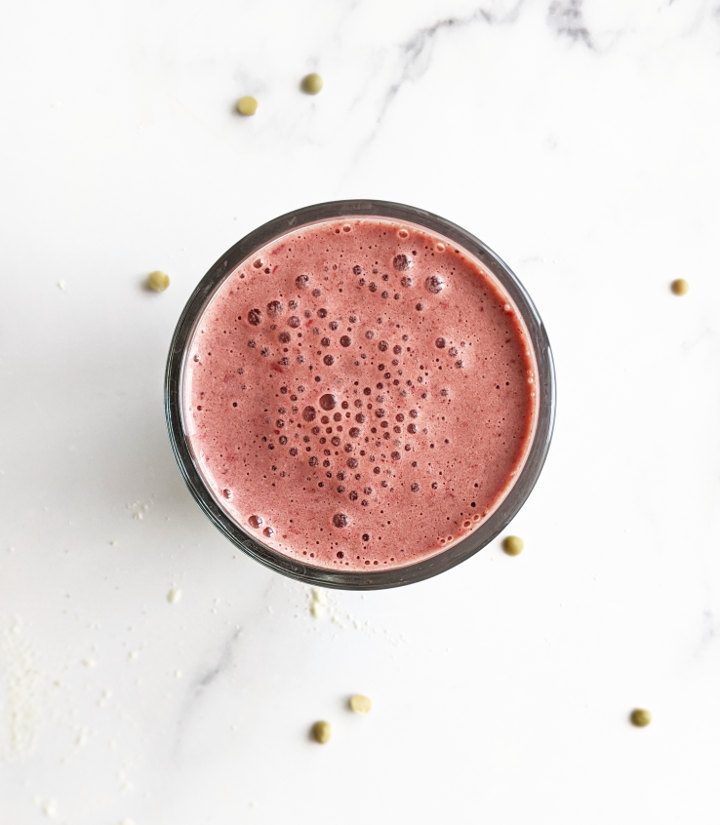
If you enjoyed this tutorial for making your own vegan protein powder please leave a comment below and give it 5 stars! Or on Pinterest (don’t forget to follow me!) you can now add pictures into reviews, too, and be sure to help me share on facebook!
If you’re looking for more easy, healthy recipes the Health My Lifestyle Meal Planner is full of them! You can easily narrow down exactly what you’re looking for with the extensive filtering options, plan out your week in seconds or grab a pre-made plan, track your calories and goals, and more! Try it for free! Check out the Meal Planner here.
Want to Save This Recipe?
Enter your email below and we’ll send it straight to your inbox! Plus, get weekly free recipes!
By submitting this form, you consent to receive emails from Health My Lifestyle.
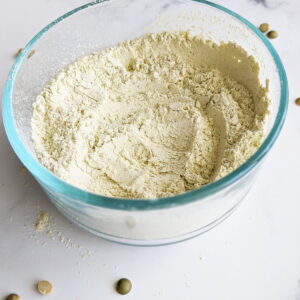
DIY Pea Protein Powder
Method
- Blender
Ingredients
- 1 cup split peas dry, uncooked
Instructions
- Place peas in a blender or food processor. I use a Ninja blender but any high-speed blender or food processor will do. Make sure whatever appliance you use is completely dry. You do not want any moisture in it or you will end up with a paste instead of a flour. Blend for around 3 minutes. Make sure any openings are covered while it's running so you don't have pea flour wafting out of it.
- Sift the processed peas over a bowl with a sieve or mesh strainer to separate the powder from any of the larger pieces. Reprocess the large pieces in your blender or food processor for another 3 minutes and sift again.
- Any leftover larger pieces can be ground using a coffee or spice grinder, or throw into a soup or stew so they don't go to waste. They're so small that they should cook quickly.
- Store pea protein powder in an airtight container in the refrigerator for up to a week or freeze for longer. See above article for how to add additional protein and flavor options to the powder.

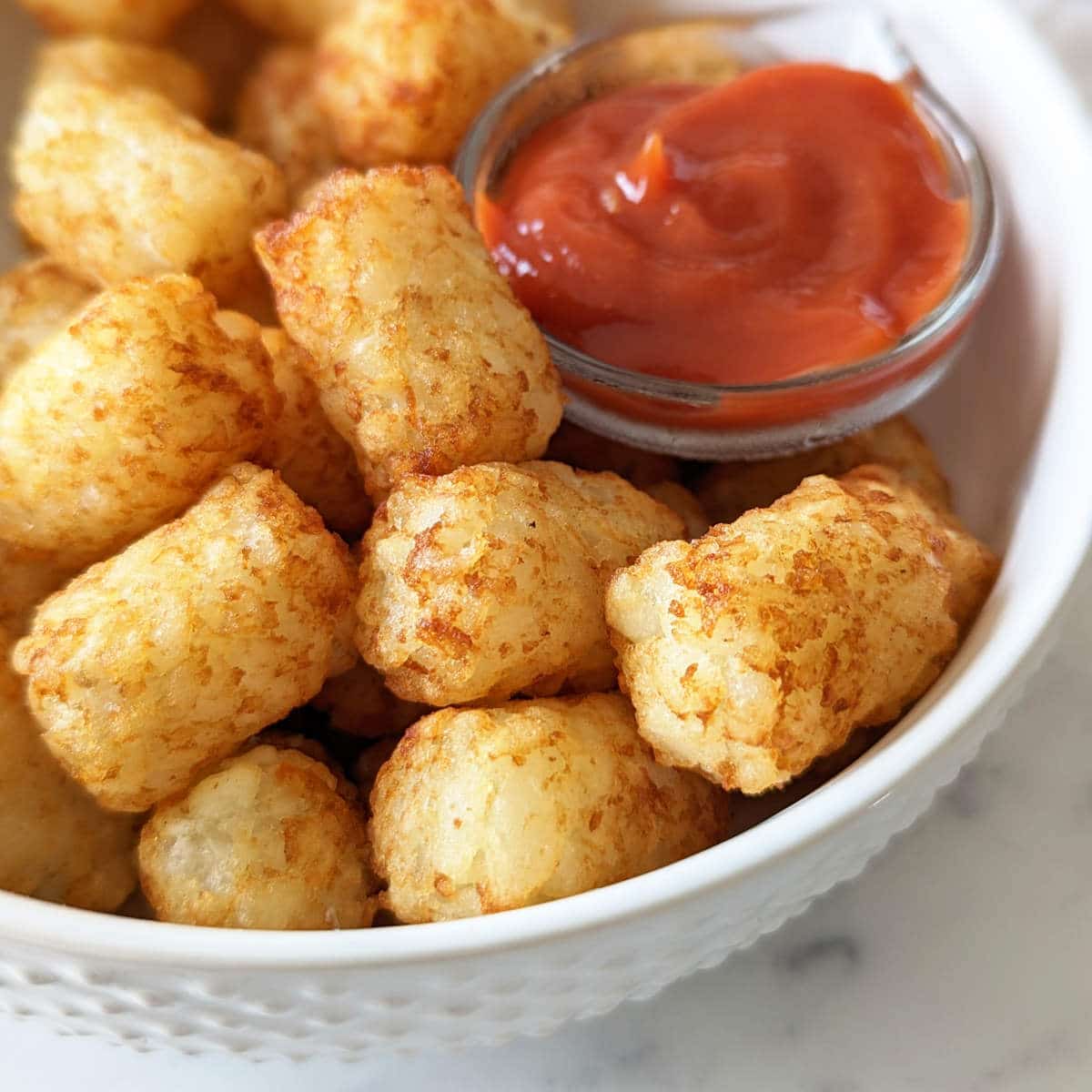
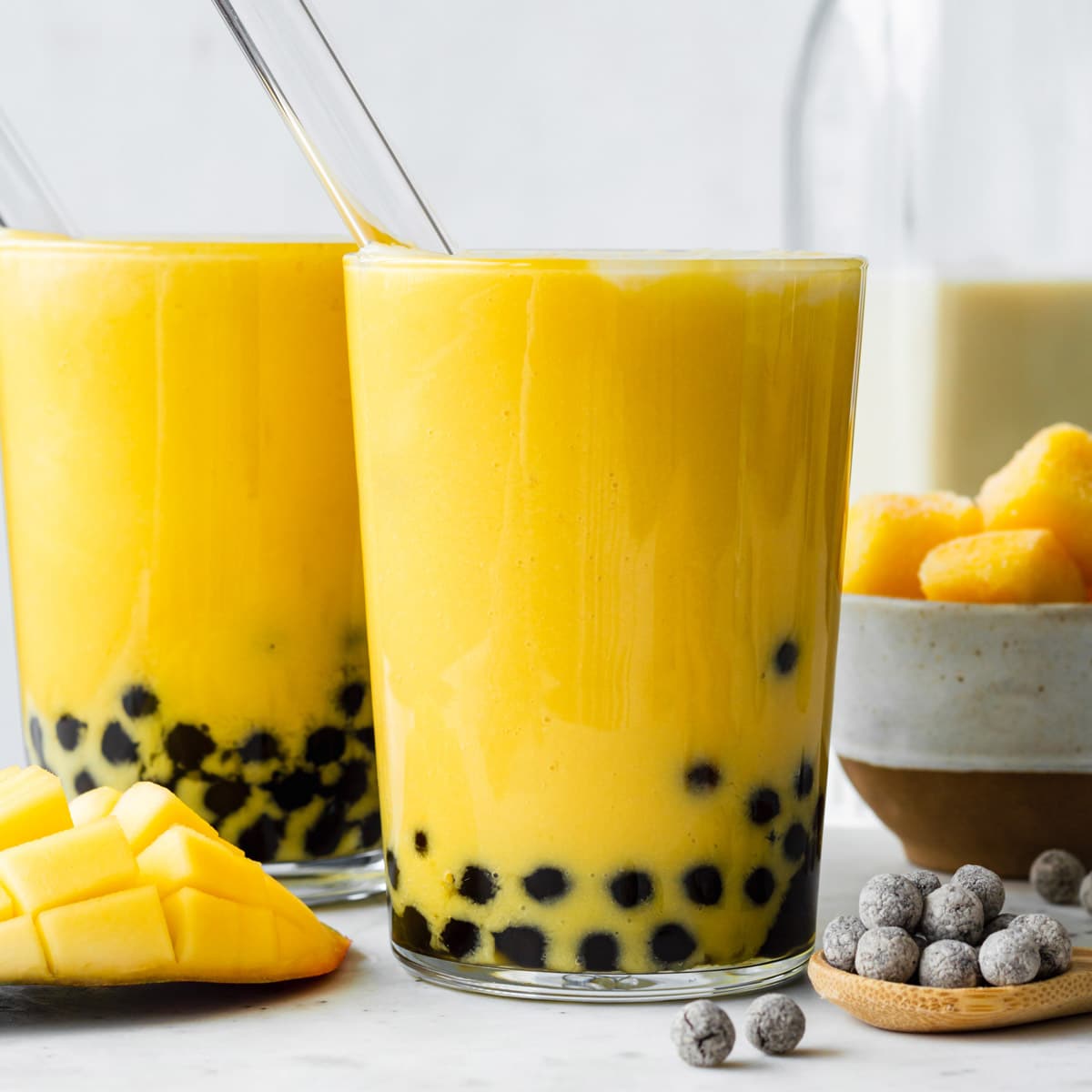
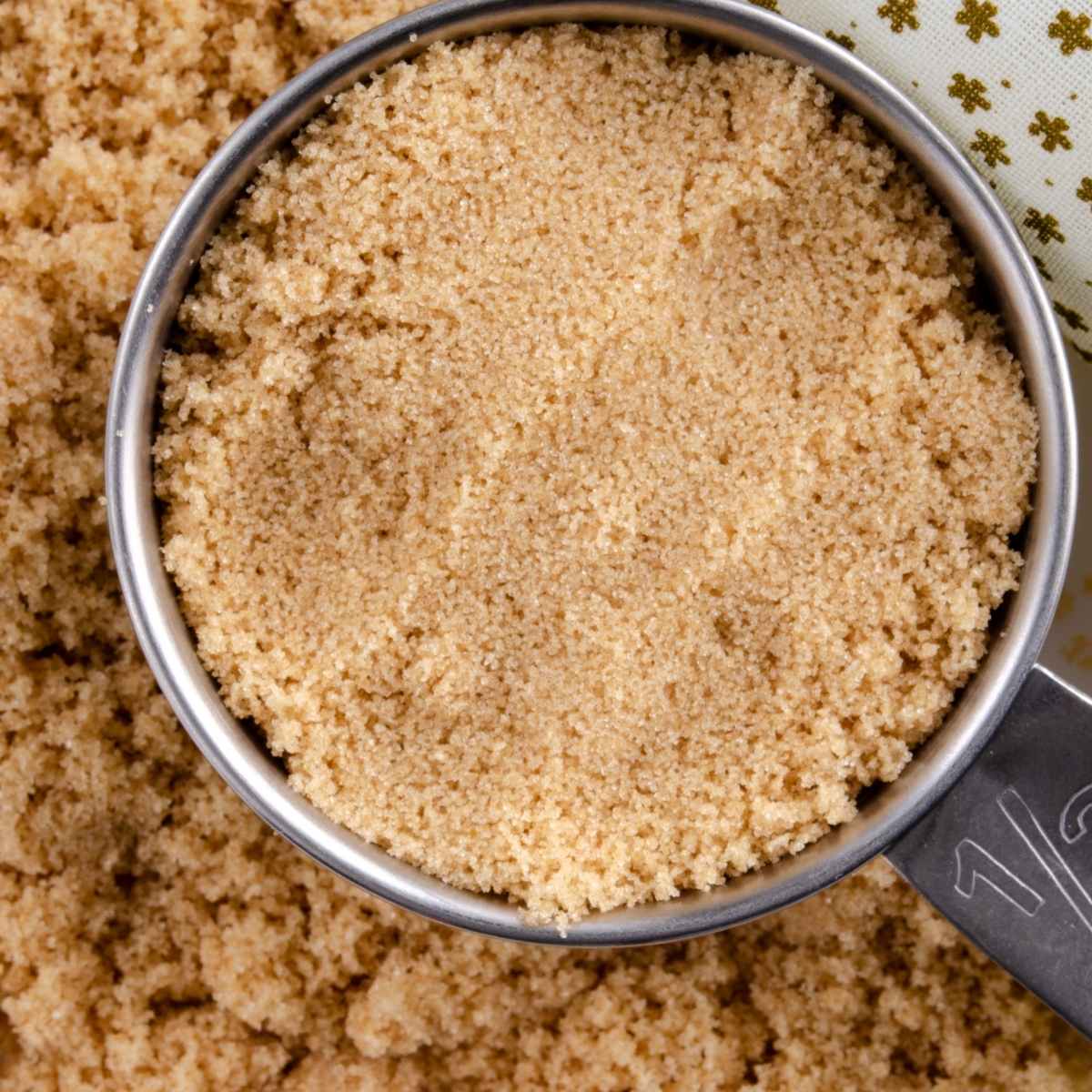
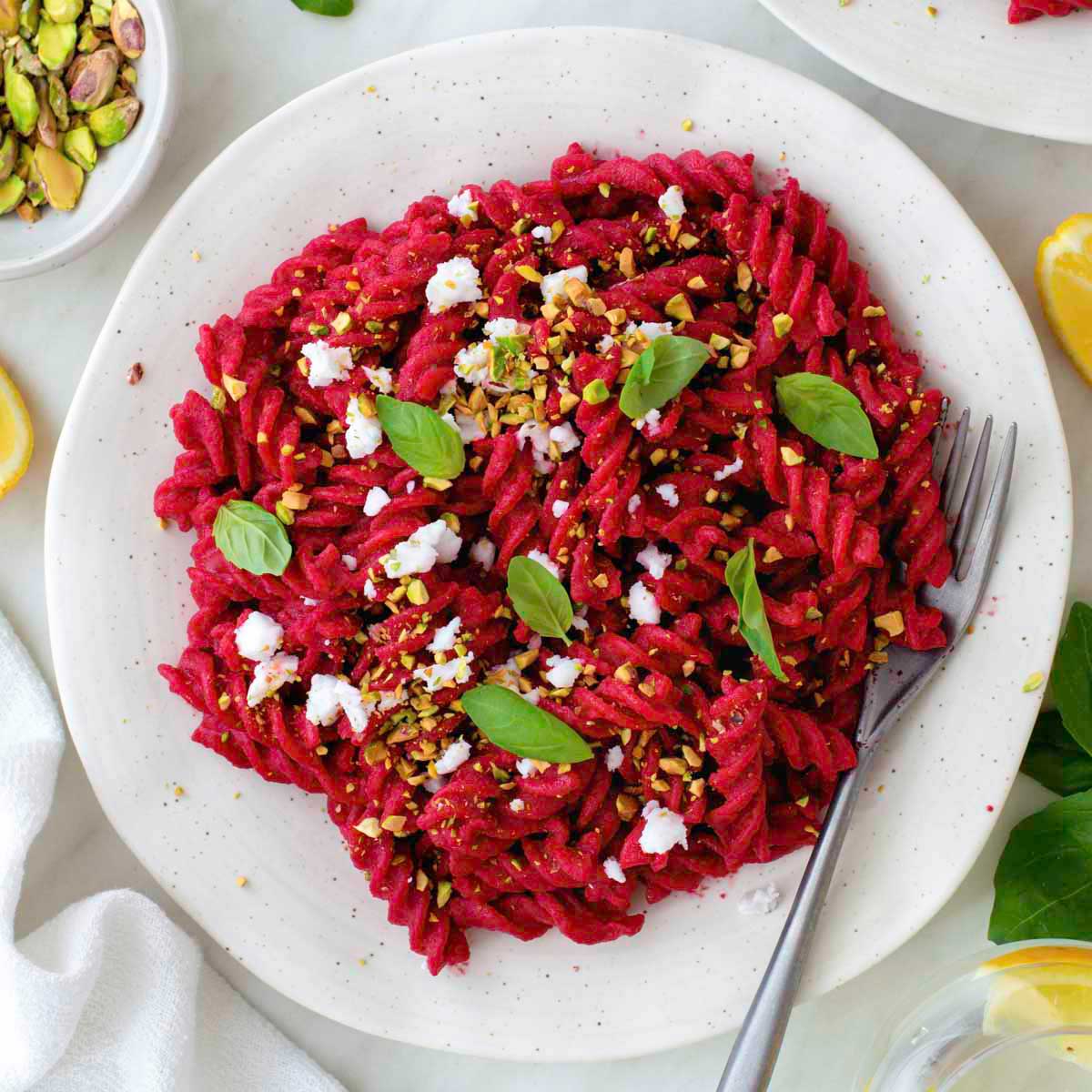
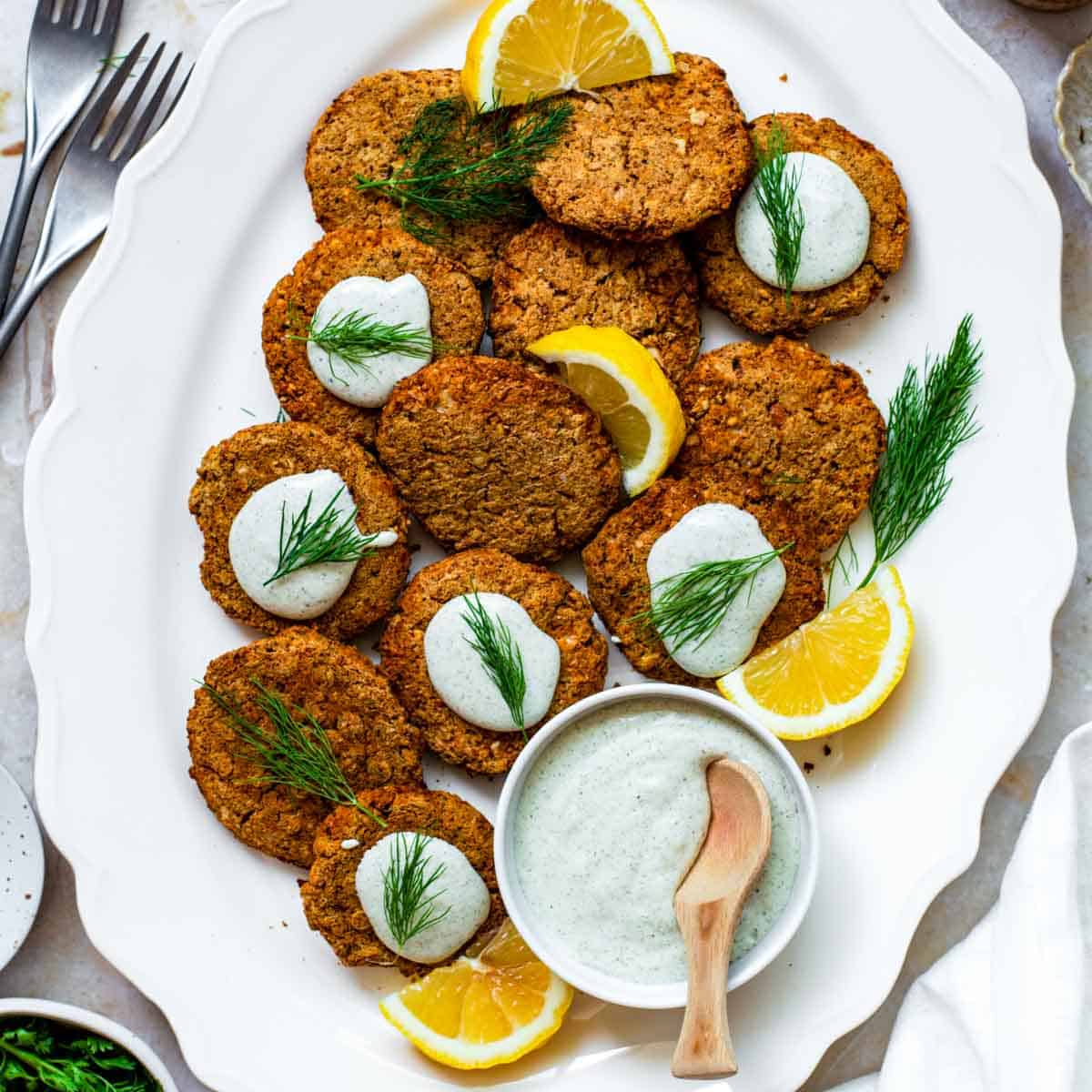
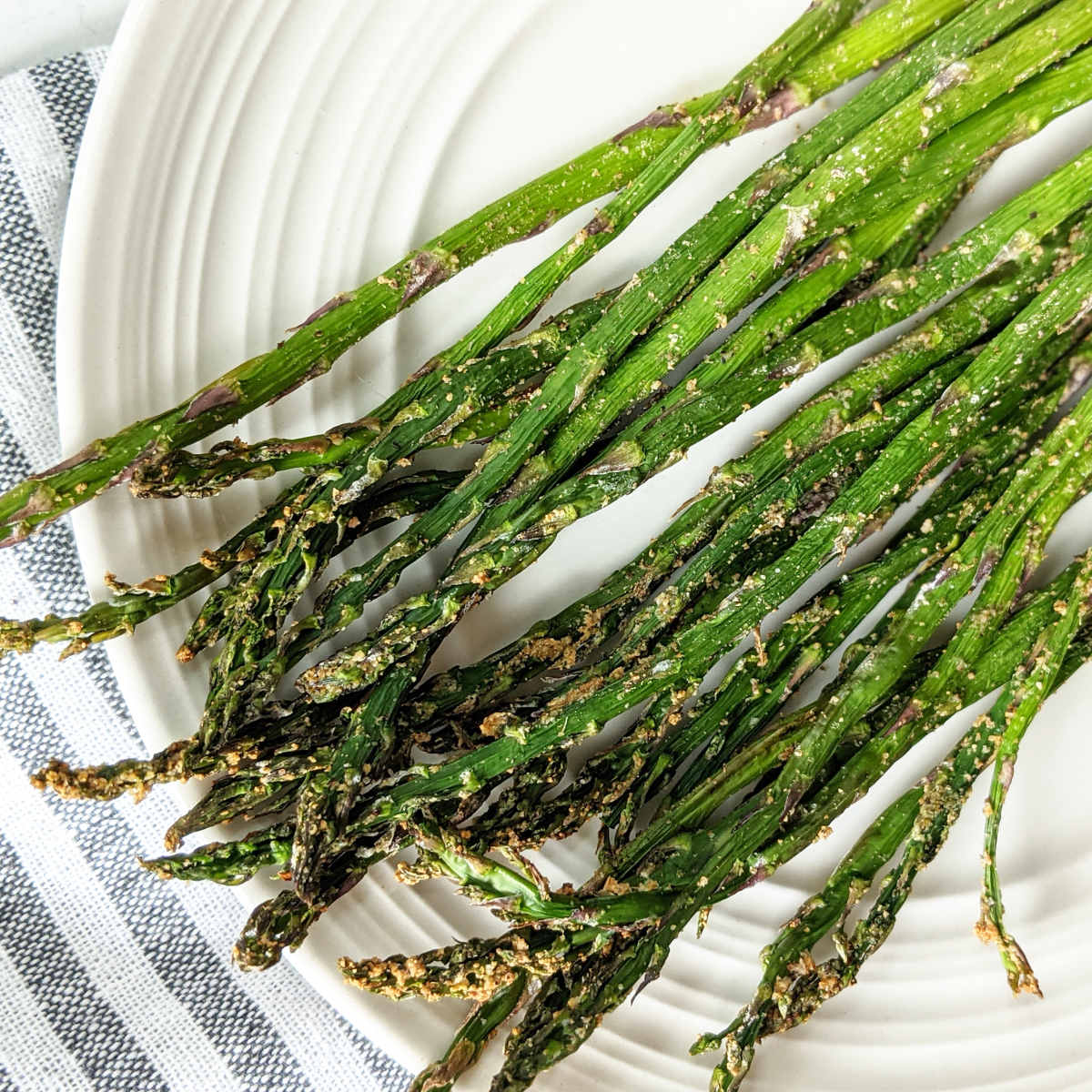
How in the world do you get past the bitter awful taste of this pea flour? I made this and it was such a pita. It took forever to get the peas to actually grind up and only did a magic bullet do the trick. I highly suggest avoiding grinding them in a food processor, you will be breathing this stuff in and it will get everywhere. When I made my smoothie mix all I can taste is the bitter pea powder flavor. I had to double all other ingredients (cocoa, almonds, flax seed, peanut utter powder, sunflower seeds, hemp hearts,& coconut sugar) in my mix. I doubt I will be adding it to the next batch of mix I make,
Hi Holly, sorry to hear it did not turn out for you. When using food processors I recommend covering the openings (as stated in the recipe directions). As for flavor, it depends on how much you’re using and what you’re combining with. Maybe start with 2 tablespoons per 16oz smoothie and see how it tastes. I also recommend blending with fruit to mask the pea flavor. Hope this helps!
nice to know how to do this easily and with variety! thank you
My own pea protein powder. Great idea, easy explanation and informative data! —will save a lot. Easy recipes! Thank you!
So happy you enjoyed it! 🙂
Thanks so much for your DIY protein powder recipe.
Now that I see that your recipe calls for split peas, I have to decide what to do. When I eat split pea soup I need to take a Beano-like supplement because of the gas. So I wonder if uncooked split peas will be have the same effect on me.
Happy you found my recipe!
I would start with a small serving at first—maybe only 1-2 tablespoons and see how it goes. It will still have the fiber so there’s a chance you’ll still need the supplement.
I really like the idea of this recipe, however other, more expensive pea protein powders, are extracted in a different way so that there is less fiber content. Fiber is great, but in order to have the protein content I’m looking for (2 servings for a total of 22g) I would end up consuming 28g of fiber in one go! I’m not sure how my stomach would hold up after one smoothie. I get my fiber in other foods I eat throughout the day. Again I love the idea of this recipe and how it would save money, but just pointing this out for other viewers 🙂
Not actually a pea protein powder and stated in your title. Consuming this is no different than eat peas which for people that have problems with fiber is a waste of time. There are good reasons people spend money for actual pea protein powder.
Agree with this. Protein powder is supposed to remove most of the other macros out of the mix, so as to be a protein supplement in addition to the diet. This recipe is just whole peas… which is all well and good, but it’s not a protein supplement.
Do you rinse the peas first, allow them to dry, and then grind them up?
I searched for DIY pea protein powder recipes because I am ready to cut my plastic waste stream, those large containers use a lot of plastic, and it’s true that not all plastic that we put into our recycle bins is actually being recycled, the market for buying waste stream plastic changed in the recent past.
I am ok with adding some more starch and fiber to my morning smoothie, because I can adjust the other starch sources in my diet to keep a healthy balance, and more fiber isn’t a bad thing. And saving $$ on expensive diet supplements is always good! Thank you for the great recipes!
Is pea protein powder healthy?
Pea protein powder is a high-quality, easily digested protein source made from yellow peas. It’s rich in iron, arginine and branched-chain amino acids and offers benefits like improved muscle growth, feelings of fullness and heart health.Nov. 30, 2018
Hi, glad to have found your blog. Just FYI I know you are trying to do good here but the reason people do buy protein powder at the store and don’t grind their own from whole peas is because it has a lot of protein without all the carbs. The brand I have right now, for a 1/4 cup serving, has 20g protein and 6g of carbs vs the homemade 11g protein for 30g of carbs. I am trying to get protein without all the carbs from regular peas.
Thanks, Annie! And I totally understand that some people may prefer the higher protein percentage but that will be difficult to do without additional equipment which defeats the purpose of this more affordable homemade version. In that case it is probably best to stick with store-bought but I would argue there’s nothing wrong with extra carbs (and fiber!) from healthy sources like peas 🙂
While I really appreciate your effort and don’t want to come across as a hater or anything, I need to point out that what you made is not protein powder but, as you also stated far into the post, pea flour. So i think the title of the post should be changed accordingly..
Hi Alessandra, thanks for your comment! I understand where you’re coming from. My thoughts are it is still protein in powder form that you can add to smoothies as a supplement the same way as store-bought protein powder. Yes, this powder has more fiber than store-bought, but I personally find that a bonus in times where people get twice as much protein as they need and only half as much fiber. I always include the nutrition information so people can decide whether it’s the right thing for their unique dietary needs.
Yeah, I was really surprised to see this claimed as protein powder. This is very misleading. Even the bit about complete/incomplete proteins is concerning. It’s incomplete in that you can’t properly cover yourself by only eating peas. It alone will not complete your protein needs, hence incomplete. Though this is admitted later in the same paragraph. A store bought protein powder will also balance this out. I get it, we want to make veganism seem simple, but these simplifications or half truths are dangerous.
But kudos to the author for leaving your comments up!
Thank you for providing the recipe. I disagree with the previous comment. The reason why I have purchased protein products is because I didn’t know that I could make protein at home. Please enable Pinterest pins for this recipe so that I can reference it later.
Also, is there a recipe that will allow for an increase in protein by combining types of vegan proteins like pea, hemp, chia, and nut powders. I would definitely be interested in making my own so I could avoid of the chemicals in store bought powders.
Thank you, Nicole! Below the last image there is a Pinterest button that will allow you to pin it for later.
In the free download there’s a guide on how to customize this protein powder with add-in’s such as those and flavoring suggestions. You can find the sign up for it right above the last image. Enjoy!
Is a great recipe thanks for sharing!
Just wondering how did you get the pea protein white-ish, mine appears greenish color.
So glad you like it! 🙂
Mine has a greenish tint too, I think it’s just the lighting that makes it look whiter in the photos.
Great, succinct info! Thanks for the excellent post.
Thanks Jenn, glad you enjoyed it! 🙂
Hi. I just made this recipe and it’s great ! I’ve read some people say that it’s dangerous to eat raw peas – salmonella being one of the issues. I know beans are toxic when unhooked and peas are not, but now I’m worried about other contaminants. Have you eaten this powder over a good period of time and if so, have you ever gotten sick ? I buy organic split peas. I washed them in bold water (not soaked) I let them dry in the sun and then used your recipe. The powder was a great addiction to my smoothies ! Should I worry about these possible issues ? How do they make the commercial protein powders? Do they heat them up, I wonder ? Thank you !
Thanks so much, I’m so glad you liked it! I haven’t ever gotten sick from it but I would imagine it’s the same risk as with any raw produce when it comes to contamination. Rinsing first and letting them dry will definitely help reduce that risk especially since organic often comes with a higher risk due to the use of manure for fertilizer. That’s probably the best route for food safety.
M- You can spread your pea protein powder out on a cookie sheet and toast it in the oven at 350 F for 20ish mins, removing every 5-10 mins to stir. As an added bonus, it also takes away some of the bitterness of the peas.
This is probably the best post about proteins that I evere found. It saves you time and money and with all those extras you can add it becomes a much healthier choice than all of those mixed powders you find around.
Thanks so much, David!
First of all, people in the comments are right, your title is misleading, it’s protein powder-like, not actual protein. You should think about it, are you really the kind of person who enjoys misleading article titles when you browse the internet? Now regarding the math, my split peas have written on the package that 100g of product contain 20 g of protein. If a serving is 2 tbs -that’s roughly 40 g, then one serving has 8g of protein, not 11!
I’ve been very straightforward in the article about the amount of protein in this homemade version and as well as in the recipe card itself. No protein powder is 100% protein. Many commercial brands include added sugars, artificial flavors, thickeners, stabilizers, vitamins and minerals. This one contains the natural sugars and fiber from peas with the natural vitamins and minerals so there’s no need to fortify it. This is why I suggest adding it to smoothies rather than as a protein shake on its own because it doesn’t contain additional flavoring. Please remember that the weight of powder will differ from the weight of whole peas at the same volume. Additionally, the serving size is 1/4 cup, which is the industry standard for protein powders. 1/4 cup is 4 tablespoons.
Hi! I’ve been looking for a recipe to make my own protein powder and after reading what you’ve written, green split peas are on my shopping list! (smile) But until I can get to the store, I’m wondering if I could do this with the freeze dried whole green peas I have on hand? I can’t wait to try the “Black Forest” smoothie. And why do you refrigerate or freeze it? I powder my freeze dried fruits but I just put the powder into glass jars with a dessicant & stick them in the cupboard. In any case, thank you for this information & I’ll be looking for your reply.
I haven’t tried with freeze dried whole green peas but from my understanding they are the same as split peas, just still intact and not peeled. I would just double check that they are the same because some legumes require cooking before consuming but split peas do not. As for storage, I find the refrigerator or freezer best because I haven’t experimented with desiccants yet. What do you typically use for it?
Health My Lifestyle, I use the dessicant to ensure the powder stays dry. Freeze dried anything is packaged with dessicant packets, so if I’m making powder, I don’t throw that packet away. I keep it & stick it in the powder. If I’m using the freeze dried stuff for cooking or baking, I leave the dessicant in the package until the contents are gone. And you can get a 50-count package of dessicant packets for food storage on Amazon for around $10. I learned about them when I was researching long term food storage.
I have whole dried peas that I use to grow pea shoots. Can I use them for making pea protein powder?
From my understanding, whole dried peas are the same as split peas, just still intact and not peeled so I would assume you could use them to make pea protein powder. I would just double check that they are because some legumes require cooking before consuming but split peas do not.
Hey, I love your recipe and have been using it for the last few days, but I’m starting to wonder if eating split peas is really safe. I know you said it is, and I usually would trust a stranger on the internet, but I’ve been looking for studies online, and it has been really hard to find quantifiable data. Do you have any links you could send my way to give me ease of heart? lol if you do that would be highly appreciated! Thank you!!
I made this recipe and ended up with food poisoning. I’m sure it has something to do with the peas that I purchased. Either wash and retry them, or I would even recommend using partially cooked or frozen peas, then dehydrating. That might eliminate the risk of food poisoning.
Hi Brooklyn, I’m so sorry to hear this! It is definitely always good to wash and dry just to be safe, especially if using organic split peas. Partially cooked or frozen is a great idea as well. I often add cooked beans or frozen peas to smoothies to add protein and make them more filling.